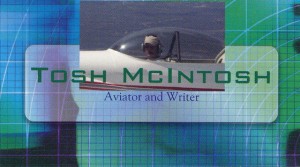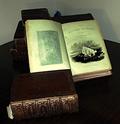 Disclaimer: The Writer’s Desk Logbook is not a podium from which universal truths and profound wisdom flow down to the masses. These posts are nothing more than personal observations about my exploration of the fascinating craft of writing.
Disclaimer: The Writer’s Desk Logbook is not a podium from which universal truths and profound wisdom flow down to the masses. These posts are nothing more than personal observations about my exploration of the fascinating craft of writing.
“Grenade in the Room” continues with Part 4:
In Part 2 of this series, I mentioned that for me it has been instructive to consider person, viewpoint, and tense both separately and as an interacting triad that is a crucial factor in a writer’s ability to create in readers the desired viewpoint experience within the fictive dream.
 With the exception of shorter pieces, I’ve never used present tense, and I seldom encounter it in the fiction I read for pleasure. A few years after I began writing, I opened a novel by an author I’d never read and immediately felt as if I’d been stiff-armed by the first page. First person and present tense just didn’t read right. In an unusual (for me) fit of literary devil-may-care bravery, I forged ahead.
With the exception of shorter pieces, I’ve never used present tense, and I seldom encounter it in the fiction I read for pleasure. A few years after I began writing, I opened a novel by an author I’d never read and immediately felt as if I’d been stiff-armed by the first page. First person and present tense just didn’t read right. In an unusual (for me) fit of literary devil-may-care bravery, I forged ahead.
What a surprise when I realized (yeah, I know, the rhyme speed-bumped you, but I couldn’t resist leaving it in) that I’d completely forgotten about person and tense and the story had me. Since that time, I’ve settled into a comfort zone with past tense, fully intending to try present (and maybe even first person!) at some point. Scary.
My justification for sticking with past tense for now is that it’s the most common and therefore more comfortable for readers, who tend not to notice it. It helps channel information between writer and reader rather than create a barrier. Readers are conditioned to it by convention and interpret a past-tense verb as happening right now. For any “rewinds” into backstory, the technique I use is to indicate transition from current story time into the past with one past-perfect verb, switch back to simple past for the duration of the rewind, then use one more past-perfect verb to clearly signal the shift back to current story time.
 Some of my writer friends recommend inserting occasional “reminder” past-perfect verbs when in backstory to keep readers oriented. I don’t much care for this technique, because I think it can be misinterpreted as a transition into current story time when none is intended. I also think that the narrative all by itself can keep readers comfortably aware of being in backstory until I “signal” them out.
Some of my writer friends recommend inserting occasional “reminder” past-perfect verbs when in backstory to keep readers oriented. I don’t much care for this technique, because I think it can be misinterpreted as a transition into current story time when none is intended. I also think that the narrative all by itself can keep readers comfortably aware of being in backstory until I “signal” them out.
As for the question of viewpoint, the following is paraphrased from Orson Scott Card’s Characters and Viewpoint and describes my approach by comparing the characteristics of omniscient with those of limited:
Omniscient is Godlike. It shows every character’s thoughts, dreams, memories, desires, using any moment in the past or the future. What omniscient does best is switch back and forth between characters and allows readers to see in each person’s mind at the time of the event. Another major quality is that no character knows as much as the reader knows, and the only accurate view is the reader’s. Omniscient can cover lots of event time in brief passages. It can tell the story in less time and reveal more characters, but this prevents readers from fully engaging with any one character. Readers are constantly reminded that the narrator is telling story. Readers can’t become fully involved and identify with characters, feel what they do, share emotions. The view is more distant, watching rather than experiencing. Omniscient is like looking at the world through the wrong end of binoculars. Readers see it all, but it’s far away.
 In limited single, readers are led through story by only one character. They see only what that character thinks, wants, remembers, and they can only guess at inner thoughts of another character.
In limited single, readers are led through story by only one character. They see only what that character thinks, wants, remembers, and they can only guess at inner thoughts of another character.
In limited multiple, the author can change viewpoint characters but only with clear division, like a chapter break or scene break and never in mid-scene. Transitional scene breaks are marked with a line space, and sometimes with three asterisks or other symbol, which appear in the finished manuscript only at page break. (This is a formatting issue that in my experience has divided the publishing world into armed camps, so I’ll not address it here.)
At these breaks, readers are conditioned by standard convention to anticipate the possibility of a major change in location, time, or viewpoint, and the writer must establish immediately after break what change has occurred, if any. This has become especially important due to today’s trend of inserting chapter breaks every couple of pages.
 Card: A major advantage of limited/third person that makes it the overwhelmingly dominant choice for today’s fiction is that it trades time for distance, obtains more intense involvement, and prevents the feeling of readers being outside looking in. Limited can’t see as many things in the same period of time as omniscient, but what it sees is up close and personal. It combines the best features of narrative style by allowing a closer look at the world through the viewpoint character’s eyes without the constant reminder that the narrator himself is showing the reader by looking back at events from some point in story’s future.
Card: A major advantage of limited/third person that makes it the overwhelmingly dominant choice for today’s fiction is that it trades time for distance, obtains more intense involvement, and prevents the feeling of readers being outside looking in. Limited can’t see as many things in the same period of time as omniscient, but what it sees is up close and personal. It combines the best features of narrative style by allowing a closer look at the world through the viewpoint character’s eyes without the constant reminder that the narrator himself is showing the reader by looking back at events from some point in story’s future.
“Grenade in the Room – Part 5” will continue this personal exploration of pov. Thanks for reading and please join me again soon.


